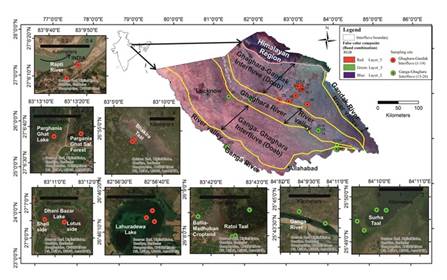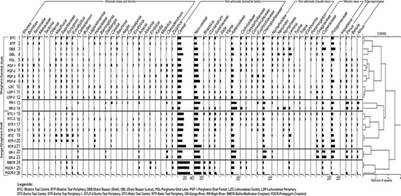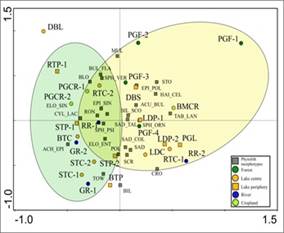Newly developed modern analogue dataset based on biotic and abiotic proxy records could be accurate reference tool for the palaeo-ecological studies in the CGP
Scientists have developed a modern analogue dataset based on biotic and abiotic proxy records from different depositional settings like lakebeds, river beds, forest floors, and croplands across two interfluves of the Central Ganga Plain (CGP) that would be an accurate reference tool for the palaeo-ecological studies in the CGP.
The Central Ganga Plain serves as a food basket for thickly populated India and is undergoing significant upheavals in terms of climatic (monsoonal) variability in recent decades. Future scenario assessment requires rigorous climate models which are built utilizing key data inputs (of this eco-system) emerged from well-dated palaeo-reconstructions.
A considerable number of records are available from the Central Ganga Plain with restricted information on palaeo-environmental reconstruction. Modern proxies to distinguish different ecology and depositional environment at the appropriate spatial scale are limited, and generation of such proxies is vital for decoding the past environment in the CGP.
Furthermore, the Ghaghara-Gandak and Ganga-Ghaghara interfluve regions are areas where several meter-thick sediments have been deposited during the Late Quaternary. The interfluve regions are comprised of different depositional environments, such as fluvial, lacustrine, forest, and croplands, so they are important for past environmental and modern analogue studies. The soil/sediment samples can be complemented with biotic (pollen, diatoms, and phytoliths) and abiotic proxies (sediment texture, stable carbon and nitrogen isotopes, XRD/ XRF elements, and magnetic susceptibility parameters).
The BSIP, an autonomous institute of DST, evaluated the strength and weaknesses of biotic and abiotic proxy records of the Ghaghara-Gandak and Ganga-Ghaghara interfluves of CGP.
For the first time, they adopted a holistic approach towards developing multiproxy modern analogues from the two interfluves, which would be an accurate reference tool for the palaeo-ecological studies in the Central Ganga Plain and surrounding areas. The study published in the journal Catena, evaluated both the strength and weaknesses of these proxies and assessed how reliably multiproxy modern analogues can identify different ecological and depositional environments and could be used as a baseline in interpreting Late Quaternary palaeo-environmental and ecological changes more accurately in this region.
The study of biotic and abiotic interactions is important as they aid in building the forest community, food crops, agro-pastoral and human settlements in this region. Consequently, the palaeo-ecological data would assist in better understanding the past and also the sustainable future projections in the Central Ganga Plain.
For example, the inception of human settlement in this region could also be traced through the establishment of marker pollen, phytolith, and diatom taxa. The high/low occurrences of annual herbs like Euphorbiaceae and Convolvulaceae (marker pollen taxa) indicated the monsoonal fluctuation in the Central Ganga Plain. Besides, the different cultural pollen taxa apprised how human-associated changes have reduced the forest cover in the CGP, and hence those forest trees should be plated that can generate and sustain our life-supporting system by giving out oxygen and also combat the rising CO2 levels by carbon sequestration.
The work stands out due to the fact that the fossil pollen represents the plant upto species level and hence could directly trace vegetation changes, and pollen could be an accurate tool for monitoring the large-scale variability in climate change scenarios.
The study would help measure the dynamics of the natural vegetation and the shifts in human occupation over time for future scenario development. This modern comprehensive dataset could provide background information for the Late Quaternary palaeo-ecological reconstruction from the Central Ganga Plain along with the practices for preserving and conserving the endangered biodiversity that flourishes in forests, crops, lakes, and rivers system of this region.
The lakes of the CGP, which were once proliferated with water and supported human settlement, are presently drying up and need to be preserved and cleaned so that the rich biodiversity flourishing in and around the lakes could be used for sustainable future development. Hence the various proxies used in this study helps in generating eco-environmental prospect of wetland and sediments status in this region.
The multiparameter study could also be viewed as an important baseline for conserving different lakes and river systems, often treated as wastelands to be drained, filled, and converted for other purposes.
https://doi.org/10.1016/j.catena.2023.106975.
For more details, please contact Dr. Swati Tripathi, email: [email protected].

Fig. 1. Map showing the study areas in Ghaghara-Gandak and Ganga-Ghaghara interfluves.

Fig.2. Pollen frequency spectra from the Ghaghara-Gandak and Ganga-Ghaghara interfluves.

Fig.3. PCA ordination plot showing interrelationships of phytolith morphs and surface samples collected from different depositional settings of the two interfluve regions of the CGP. The green coloured circle represents samples collected from the Ganga-Ghaghara interfluve region and the yellow circle represents those from the Ghaghara-Gandak interfluve region.

